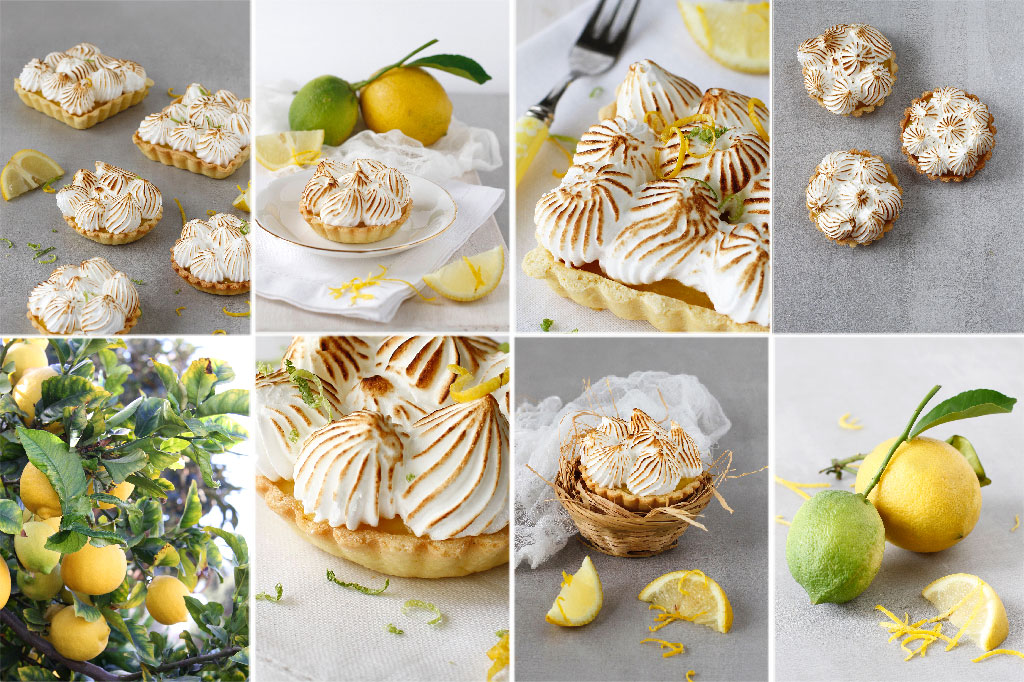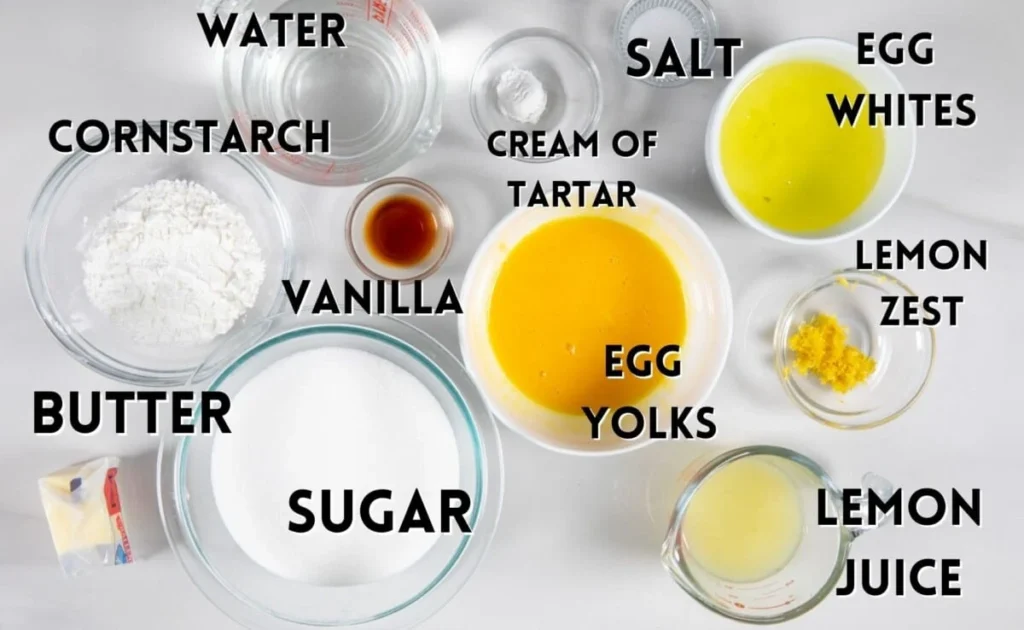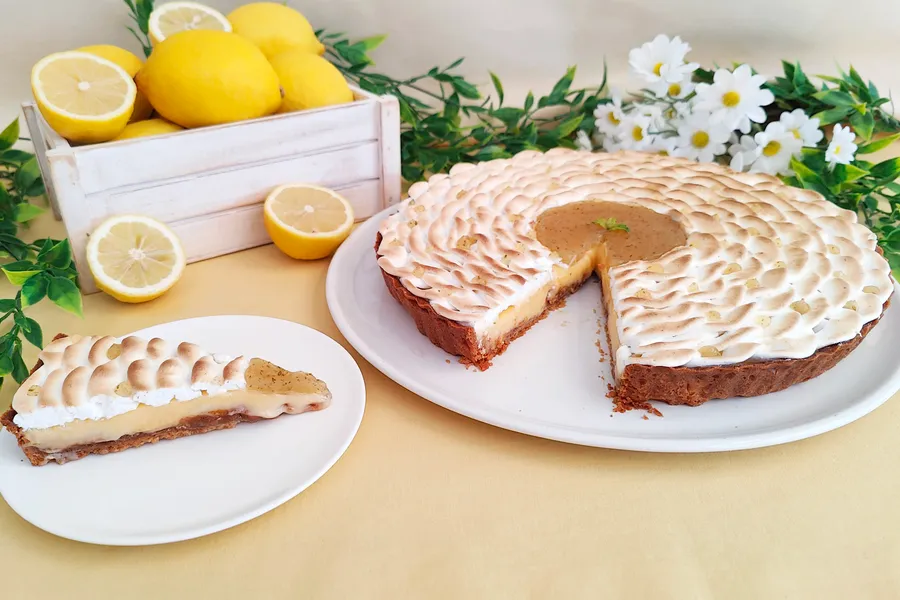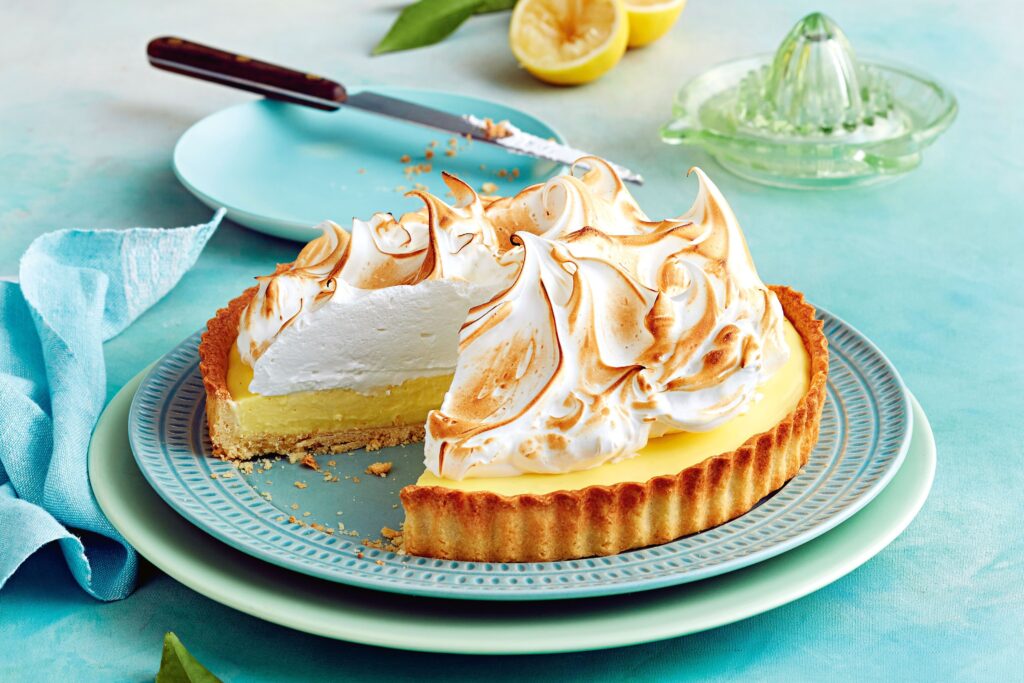INTRODUCTION ABOUT LEMON MERINGUE PIE
Lemon meringue pie is a classic dessert pie consisting of three main components: a flaky pastry crust, a tangy lemon custard filling, and a light, airy meringue topping. The pie is typically baked, with the meringue added directly on top of the lemon filling and then browned, often in the oven or with a kitchen torch. This creates a delightful contrast in textures and flavours the crispness of the crust, the smooth and tart lemon filling, and the fluffy, sweet meringue.

Lemon flavoured custards and puddings have been enjoyed since the Middle Age. The addition of meringue as a pie, as a topping to these desserts, including pies, emerged in the 18th century, initially in France. The lemon meringue pie, as it’s known today, likely developed in the 19th century in the United States, evolving from existing lemon pies to include the meringue topping. This combination quickly gained popularity, possibly influenced by pastry chefs like Elizabeth Goodfellow, who popularized meringue in cream pies in Philadelphia during that era.
The name “Lemon Meringue pie” itself appears in cookbooks by 1869, though it was often called “lemon cream pie” at the time. Today, it remains a beloved dessert, appreciated for its balanced flavors and textures, making it a favourite for various occations.
What is Lemon Meringue Pie?
Lemon meringue pie is a dessert pie made with three key layers:
- Pie crust – Usually a shortcrust or flaky pastry shell that holds the filling.
- Lemon curd filling – A thick, silky custard made from lemon juice, sugar, eggs (or egg yolks), and sometimes butter.
- Meringue topping – Whipped egg whites with sugar, spread over the lemon filling and baked until golden.
The result is a pie that’s crisp on the bottom, tart and creamy in the middle, and light and airy on top.
Perfect Lemon Meringue Pie
- Prevent weeping meringue: Spread meringue all the way to the crust edge to seal in the filling; bake it long enough to set.
- Use fresh lemons: Bottled lemon juice won’t provide the same brightness or depth.
- Cool before slicing: Chill the pie thoroughly so the filling sets properly.
- Make meringue while filling is hot: This helps the layers bond and prevents separation.
Ingredients Table
| Component | Ingredient | Quantity |
|---|---|---|
| Crust | All-purpose flour | 1 ¼ cups (150 g) |
| Unsalted butter (cold) | ½ cup (115 g) | |
| Salt | ¼ tsp | |
| Granulated sugar | 1 tbsp | |
| Ice water | 3–4 tbsp | |
| Filling | Egg yolks | 4 large |
| Granulated sugar | 1 cup (200 g) | |
| Cornstarch | ¼ cup (30 g) | |
| Water | 1 ½ cups (360 ml) | |
| Lemon juice (fresh) | ½ cup (120 ml) | |
| Lemon zest | 1 tbsp | |
| Unsalted butter | 2 tbsp (30 g) | |
| Meringue | Egg whites | 4 large |
| Cream of tartar | ¼ tsp | |
| Granulated sugar | ½ cup (100 g) | |
| Vanilla extract (optional) | ½ tsp |

Instructions
1. Make the Crust
- In a bowl, combine flour, salt, and sugar.
- Cut in cold butter until mixture resembles coarse crumbs.
- Add ice water 1 tbsp at a time, mixing just until dough comes together.
- Form into a disk, wrap, and chill for 30 minutes.
- Roll out and fit into a 9-inch pie pan.
- Prick the base, line with parchment and baking weights, and blind bake at 375°F (190°C) for 15 minutes.
- Remove weights and bake 10 more minutes until golden. Cool.
2. Prepare the Lemon Filling
- In a saucepan, whisk together sugar and cornstarch.
- Gradually whisk in water, lemon juice, and zest.
- Cook over medium heat, stirring constantly, until thickened and bubbly.
- Reduce heat, cook 2 more minutes.
- Beat egg yolks in a bowl. Slowly whisk in a few spoonfuls of hot mixture to temper.
- Return egg mixture to saucepan and cook 2 more minutes.
- Remove from heat and stir in butter. Pour into pie crust.
3. Make the Meringue
- Beat egg whites with cream of tartar until soft peaks form.
- Gradually add sugar, beating until stiff, glossy peaks form.
- (Optional) Add vanilla extract and beat briefly.
4. Assemble and Bake
- Spoon meringue over hot filling, sealing edges to crust to prevent shrinking.
- Use a spatula to create decorative peaks.
- Bake at 350°F (175°C) for 10–12 minutes, or until meringue is golden brown.
5. Cool and Serve
- Let pie cool completely at room temperature, then refrigerate for at least 4 hours before slicing.

Storage and Serving
- Best served the day it’s made, once cooled.
- Store leftovers in the refrigerator for up to 2 days.
- Avoid covering tightly with plastic wrap—it can make the meringue collapse or weep.
Nutritional Role of Lemon Meringue Pie
| Component | Key Ingredients | Nutritional Role |
|---|---|---|
| Crust | Flour, butter, sugar | Provides carbohydrates and fats for energy. Butter contributes saturated fat, which should be consumed in moderation. |
| Lemon Filling | Lemon juice, sugar, egg yolks, cornstarch | Lemon juice provides vitamin C (antioxidant). Egg yolks offer protein, vitamin A, D, and healthy fats. Sugar contributes simple carbohydrates (quick energy but low nutrient density). |
| Meringue Topping | Egg whites, sugar | Egg whites are a low-calorie source of protein. Sugar adds sweetness and calories but lacks vitamins or minerals |
Key Nutritional Highlights
- Vitamin C: From lemons; supports immune function and skin health.
- Protein: From eggs (yolks in filling and whites in meringue).
- Energy: High in calories due to sugar and fats.
- Fats: Butter adds saturated fat; egg yolks provide cholesterol and fat-soluble vitamins.
- Low Fiber: Minimal to no dietary fiber unless whole grain crust is used.
Health Consideration
- Occasional Treat: Due to high sugar and fat content, it’s best enjoyed in moderation.
- Portion Control: A small slice can satisfy a sweet craving while keeping calories in check.
- Homemade Versions: You can make healthier versions using less sugar, whole wheat crust, or natural sweeteners.
Popular Lemon Pie Variations
| Variation | Description |
|---|---|
| Lemon Meringue Pie | Classic version with tangy lemon filling and fluffy, browned meringue topping. |
| Lemon Cream Pie | Uses sweetened condensed milk and whipped cream for a smooth, creamy texture — no meringue. |
| Lemon Icebox Pie | A no-bake version often made with lemon juice, condensed milk, and a graham cracker crust; chilled to set. |
| Lemon Tart | A French-style open tart with a crisp pastry shell and smooth lemon custard filling. |
| Lemon Chiffon Pie | Light and airy texture from folding whipped egg whites or whipped cream into the lemon filling. |
| Vegan Lemon Pie | Made without eggs or dairy — often uses coconut milk, tofu, or agar-agar with lemon juice and zest. |
| Keto Lemon Pie | Low-carb version using almond flour crust, sugar-free sweeteners, and keto-friendly thickeners. |
| Mini Lemon Pies / Lemon Tartlets | Bite-sized versions perfect for parties or portion control. |
| Lemon Blueberry Pie | Adds blueberries to the filling or topping for a sweet-tart fruit combination. |
| Lemon Coconut Pie | Combines shredded coconut into the filling or topping for extra flavor and texture. |

Key Ingredients
- Pie crust: All-purpose flour, butter (or shortening), a bit of sugar, salt, and cold water.
- Lemon filling: Fresh lemon juice, lemon zest, sugar, egg yolks, cornstarch or flour (as a thickener), and butter.
- Meringue: Egg whites, granulated sugar, sometimes cream of tartar for stability.


